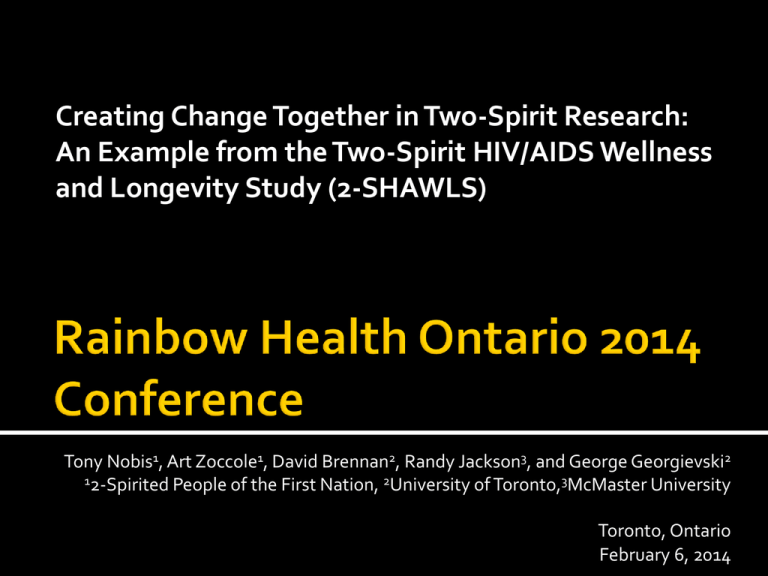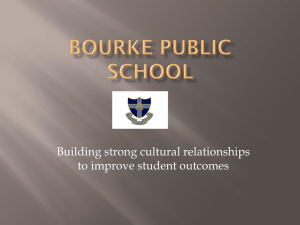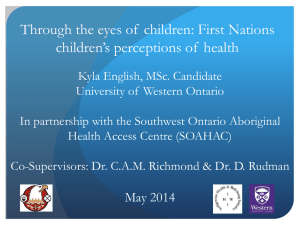
Creating Change Together in Two-Spirit Research:
An Example from the Two-Spirit HIV/AIDS Wellness
and Longevity Study (2-SHAWLS)
Tony Nobis1, Art Zoccole1, David Brennan2, Randy Jackson3, and George Georgievski2
12-Spirited People of the First Nation, 2University of Toronto,3McMaster University
Toronto, Ontario
February 6, 2014
Catalyst Grant funded by the Canadian Institutes of Health
Research (No. 492662)
Research Team
Investigators: David J. Brennan (PI), Art Zoccole (Principle
Knowledge User), Randy Jackson (Co-I), andTony Nobis (Co-I)
Research Staff: Earl Nowgesic (PhD candidate), Chavisa Brett
(Research Coordinator), and Georgi Georgievski (Undergraduate
Research Assistant)
Advisory Committee
OAHAS—the Ontario Aboriginal HIV/AIDS Strategy— (Doe
O’Brien-Teengs, Heather Chierici, Sharp Dopler, and Lyndon George)
Nine Circles Community Health Clinic (Petanacoot Nenakawekapo)
Toronto Aboriginal Care Team (Alita Sauve)
Union of Ontario Indians HIV/AIDS Program (Jodi Cotter)
David Brennan, Chavisa Brett, Art Zoccole, Randy Jackson, Tony Nobis, and Georgi
Georgeivski. Missing: Earl Nowgesic
Aboriginal peoples are over-represented
Aboriginal peoples are “3.8% of the Canadian population … and
yet an estimated 4,300 to 6,100 Aboriginal people were living with
HIV (including AIDS) in Canada in 2008 (i.e., 8.0% of all prevalent
HIV infections)” (PHAC, 2010, p. 2).
Youth
(15-29)
Women
Injection Drug Use
• 32.6% (Aboriginal)
• 20.5% (non-Aboriginal)
• 48.8% (Aboriginal)
• 20.6% (non-Aboriginal)
• 66% (Aboriginal)
• 17% (non-Aboriginal)
(PHAC, 2010)
4
Aboriginal people are more likely to have a later diagnosis compared
to non-Aboriginal people (Stokes, Pennock, & Archibald, 2006)
Slower uptake of anti-retroviral treatments (Wood et al, 2006)
Less access to experienced physicians (Miller et al, 2006)
Higher morbidity
Shorter survival times
A mortality rate three times higher than for non-aboriginals (Lima, 2006)
A community-identified concern
How best to deliver services that support resiliency
Intersections of racism, colonization and homophobia represent distinct issues
5
Two-spirit men represent a distinct population
20% of all new HIV infections in 2008 (PHAC, 2010)
Two-spirit men experience a higher portion of injection drug use than non-
aboriginal MSM (PHAC, 2011)
72% of all Aboriginal people living with HIV have an AIDS diagnosis
“Leading an Extraordinary Life: Wise Practices for a HIV Prevention
Campaign for Two-Spirit Men” (Thoms, 2007)
Barriers identified for suitable HIV prevention programs for two-spirit men
▪ Homophobia
▪ Access to care related to self-worth
▪ Inclusion of relationships two-spirit men have with their families and
spiritual connections
Dearth of information about resiliency, strengths, assets of two-spirit
men living long-term with HIV/AIDS
Two-spirit refers to men and women who self-identify as
possessing both male and female attributes
Masculine/feminine spirit
Live between gendered experiences or roles
Embedded in cultural understanding of roles (e.g., seers,
visionaries, healers)
A gender designation / does not refer to sexual orientation
Useful but provides only a partial description
Paints an overall picture of suffering and dysfunction (Lavallee & Poole, 2010)
among Aboriginal people
Contributes to the construction of Aboriginal identity that shape
responses (Bond, 2005; Reading & Nowgesic, 2002)
Need for research that also focuses on thriving health, including
wellness for two-spirit men living long-term with HIV
Anecdotal evidence—based on three decades of community work among
two-spirit men—documents the ways in which this population is faring
well
Literature provides little to no information about resiliency, strengths,
assets of two-spirit men living with HIV and ways this can be used to
support community efforts
To better understand the factors, skills, resources,
knowledge and practices that contribute to two-spirit
men’s health and well-being living with HIV
Conduct a comprehensive review of the literature
Conduct a series of focus groups
Further develop community/academic partnerships
Utilize results to develop a larger study focused on strengths,
resiliencies and assets of two-spirit men living with HIV
Literature review
Sharing circles/focus groups
Used Arksey and O’Malley (2007) scoping review process
Refine, clarified and linked goal of review with with research
questions
Searched for relevant studies – breadth and comprehensiveness
Selected appropriate studies for inclusion
Charted the data – comparative analysis
Collated and summarized results – using Nvivo – thematic
analysis
Stakeholder consultation
Note: The asterisk (*) is a wildcard character
allowing for a search of any word with that prefix.
Orientation
"2-spirit*"
"two-spirit*"
"two spirit*"
LGBT*
GLBT*
intersex*
pansexual*
bisexual*
gay*
homosexual*
lesbian*
queer*
trans
transsexual*
transgender*
omnisexual*
genderqueer*
"gender queer*"
"gender-queer*"
MSM
"F to M"
"M to F"
heterosexual*
"A-sexual*"
"third gender*"
"fourth gender*"
"double sex*"
doublesex*
"twin spirit*"
twinspirit*
People
A
N
D
Aboriginal*
Aborigine*
Indigenous
native*
"first nation*"
"first-nation*"
"1st nation*"
"1st-nation*"
Indian*
Amerindian*
tribal
autochtone*
amerindien*
Aborigene*
indigene*
Condition
A
N
D
HIV
HIV positive
HIV-positive
HIV/AIDS
HIV and AIDS
Living with HIV
Living with AIDS
Living with HIV/AIDS
HIV affected
Approach
A
N
D
resilient*
resilience*
resiliency
Coping
Cope*
"Protective Factor*"
"Protective Process*"
wellbeing
"well-being"
"well being"
"optimal health"
"mental health"
strength*
wellness
Does the article include a focus on Aboriginal peoples?
Does the article address two-spirit, gay, bisexual or
transgender issues?
Does some component or all of this article address the
intersection of living with HIV for more than two years?
Is resilience in its broadest form (wellness, coping, strength)
addressed in the article?”
Electronic Databases (n=12)
Proquest
Scopus
Medline
EMBASE
CINAHL
Web of Knowledge
PsychInfo – Ovid
Social Work Abstracts - Ovid
LGBT Life
Bibliography of Native North Americans
Native Health Database
Indigenous Studies Portal
Total References
Duplicates
Excludes (By at least two reviewers)
Total Yield Included
1,831
2,544
1,557
2,335
621
1,850
2,265
78
753
246
575
1,001
15,779
8,627
7,109
43
Mutual learning about western research protocols and
requirements, and indigenous knowledge and methods;
Incorporated relevant and significant indigenous
spirituality; Development of the team in relation to
having a long-term APHA, two-spirit and AIDS friendly
Spiritual Helpers on the Advisory Board (CAB);
Advising the Research Team on how Aboriginal cultural
protocols can complement western research
methodology;
Finding suitable Research Advisory Team members
who are of Aboriginal descent;
Designing a recruitment strategy and hiring process
sensitive to western and Aboriginal requirements;
Balancing western and Aboriginal priorities;
Selection of staff, Aboriginal does not automatically
mean suitable, lack of cultural-sensitivity v. being
over-apologetic;
Both Aboriginal and non-Aboriginal team members worked
collaboratively preparing for our submission to the REB;
Aboriginal members suggested methods, priorities, cultural
practices that work, the academics suggested how such
things would be viewed and responded to by the REB;
Freedom to ‘adapt as we go’ was severely curtailed once our
plan went before the university Research Ethics Board;
Established protocol eliminated involvement of nonacademics in some areas of the research process; setting up
sites, direct communication with participants, and
recruitment;
Focus group recruitment (role of team members in terms
of confidentiality)
Lower numbers based on confidentiality in a group
Academics sought direction from the Aboriginal team
and board members to indigenize how we were going
to ask the questions;
Alita Sauve and Tony Nobis developed the concept for
a Medicine Wheel floor map so focus group participants
could physically move onto sections of the map as they
told their story;
Focus groups are sharing circles
(Lavallee, 2009; Poff, 2006; Rothe et al,
2009)
Moderated by a two-spirit man
living with HIV and a traditional
helper
Use of traditional/ancestral
knowledge (e.g. reflects oral
culture)
Symbol-based inquiry (e.g.,
Ojibway medicine wheel used to
stimulate dialogue about
strengths, assets, resiliency)
3 sharing circles planned with a
total of 14 participants involved
Ethical review (University of
Toronto and McMaster University
What's allowing you to live well long-term
with HIV?
Aboriginal team members were discouraged from
contacting Circle moderators directly to avoid any
concern of coercion of participants (who may already
have a relationship with the circle moderator and the
team members.
Local supports if participant gets triggered, personality
clash potential as a barrier, etc.
No direct communication between Aboriginal research
team members and identified Sharing Circle
moderators/participants; in order to make sure the
“list” of names was kept private and not accessible to
anyone.
Recruitment proved challenging due to
confidentiality, transportation, no familiar Aboriginal
‘touch’, no way to know who already signed on so
Aboriginal team members could chase down
potential participants being missed;
No direct way of Aboriginal research team members
to know who was already contacted and who was
being overlooked;
Some moderators expected Aboriginal research
team members to be present at Sharing Circles;
Academics were informed that Aboriginal team
members knew who was speaking through the
transcripts because we know our ‘family’ life stories,
how they talk, what they typically talk about, and
where the focus group happened;
Adding such things as Clans and names of places
referred to within their stories to the list of identifiers;
Confidentiality challenged engaging Circle moderators,
preparing sites, recruitment;
Non-Aboriginals sought
direction on sections of
transcripts which did not
answer the questions being
asked, rather espoused
teachings and cultural
knowledge;
Balancing research need to
categorize while coding
holistic world-views implied
during focus groups;
Line by line coding
Development of 5 meta themes
Reduced meta themes to the four
quadrants of the medicine wheel
Selected the most
meaningful/relevant codes from the
meta themes by ranking them
Data were organized by code,
printed and attached to foolscap
which allowed for team to highlight
and discuss most salient quotes for
each code.
Using a participatory
analysis approach (Flicker
and Nixon, 2014), all team
members then read
transcripts and selected
quotes they felt were
relevant to answering the
study question
Selected quotations were
mapped onto the medicine
wheel
Identification of
relationships between codes
These relationships
were named and came
to be recognized as the
key components to
understanding
resilience among TwoSpirit HIV positive
males.
Differing World Views, Perspectives, Priorities,
and Requirements
The academics approached this research project
according to what they believe to be proper and in
accordance to the rules of formalized western
institutes.
Aboriginal members hold our culture, tradition,
knowledge and methodologies to be just as valid, if
not more relevant to our people. In essence, we had
to build our own vocabulary as we worked together.
(e.g. Two-eyed seeing)
Ownership, Control, Access, and Possession
Easily achieved (used CAAN’s “Principles of Research
Collaboration”)
▪ Collaboratively designed the study
▪ Methods (Sharing circles, medicine wheel, 7 sacred teachings)
▪ Used participatory analysis
▪ Agreement that community partners could do further, more
specific research projects in the future
▪ Consistent with the Indigenous methodologies, further use
will acknowledge 2SHAWLS
▪ Honours relationships, sources of knowledge, etc.
▪ The data belong to the community as much as to the
researcher
▪ All administrative decisions were made by either 1)
consensus of the team or 2) between the PI and the Principal
knowledge user
Sharing the findings with you all …
The findings will be presented at a variety of
venues: CAAN, AIDS 2014, OHTN
conference, workshops, community forums,
online, manuscripts
Involvement of local Aboriginal Ontario-based organizations to
provide guidance and feedback
International Indigenous Working Group on HIV and AIDS
To strengthen the collaboration and partnership between international
Indigenous communities and stakeholders in the fight against HIV and
AIDS
International Indigenous Pre-Conference on HIV/AIDS to AIDS
2014 – Sydney , Australia
“Exploring the Health and Wellness of Long-Term HIV-positive Two-
Spirit Men in Ontario”
Gage interest and possibly build international
collaboration/partnership
Exploring funding opportunities for national/international work
United States, New Zealand, Australia, Peru, Chile








